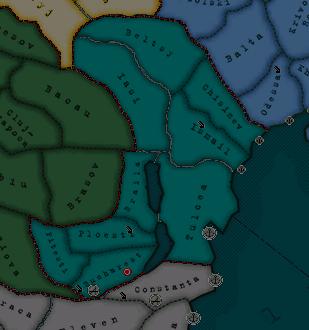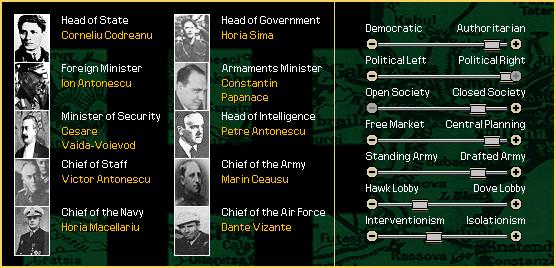Romania
From Kaiserreich
(Southern Dobruja is a better-known name for the region than Quadrilateral.) |
(→History) |
||
| Line 48: | Line 48: | ||
== History == | == History == | ||
| - | + | Following the Union of the Principalities of Wallachia and Moldova under Cuza in 1859, the coronation of King Carol I, a German-borne prince, in 1866 and the achieving of complete independence from the Otoman Empire in 1878 Romania began its slow process of modernization and of turning to the west. In 1913 it entered the Second Balkans War, tipping the balance against Bulgaria and subsequently annexing southern Dobrogea from them. With the outbreak of WW1 in 1914 Romania initially remained neutral but would join the Entente in 1916, led by Carol's successor Ferdinand. After a failed attempt to invade Transylvania, nearly 2/3 of the country was occupied by the Central Powers. Even though the army fought an effective defensive war from its last remaining holdout in Moldova, the government was forced, following the Russian collapse, to sign the Treaty of Bucharest in 1918, handing over the southern half of the country and having the economy subjugated. The treaty was never ratified and by the end of the Weltkrieg a new treaty consisting of milder terms was drawn. The southern part of Dobrogea was returned to Bulgaria, Oltenia was de-militarized, the oilfields were leased to Germany until 2012 and various other sectors of the economy became dominated by German and Austrian companies, with Romania getting the province of Bessarabia from the fallen Tsarist Empire in return. After the death of Ferdinand in 1927, the military managed to effectively seize the reigns of government, installing the 6 year old Mihai, Ferdinand’s grandson, as their puppet king, completely bypassing Carol II, the old king’s disgraced son. Of the various political groups the generals co-opted, the extremist right-wing Iron Guard led by Corneliu Zelea Codreanu proved the most dangerous. He and his organization managed in time to acquire more and more power within the state apparatus, co-opting many army generals and other influential leaders, eventually violently ousting the part of the military government still opposing him in 1935 and setting himself up as head of state, just as the young king fled the country. Codreanu now rules over a divided nation, promising to restore Romania to its former greatness, throw off the shackles of its oppression and be rid of its enemies both foreign and domestic.vided nation, promising to restore Romania to its former greatness, throw off the shackles of its oppression and be rid of its enemies both foreign and domestic. | |
| - | Following | + | |
| - | + | ||
| - | + | ||
| - | + | ||
| - | The treaty was never ratified and by the end of the | + | |
== Politics == | == Politics == | ||
Revision as of 00:59, 4 December 2016
| ||||
| Motto Totul Pentru Ţară (Everything for the Country) | ||||
| Anthem Deşteaptă-te, române! (Awaken, Romanian!) | ||||
 Romania and it's neighbors | ||||
| Official Language | Romanian | |||
| Capital | Bucharest | |||
| Head of State | Corneliu Zelea Codreanu | |||
| Head of Government | Horia Sima | |||
| Establishment (De Facto) Reunification of Wallachia and Moldavia | January 24, 1859 | |||
| - Officially recognised independence | July 13, 1878 | |||
| - National-Legionary State | 1929 | |||
| Government | Presidential republic | |||
| Currency | Romanian leu | |||
| Area | Approx 70 000 km² | |||
| Population | About 6 milions | |||
Romania, officially the Romanian National-Legionary State (Romanian short form: România; Romanian long form: Statul Naţional-Legionar Român) is a country in South-East Europe. It is governed by the Populist Iron Guard movement. It is usually called Iron Guard Romania. It is bordered by Galicia-Lodomiera to the north, Ukraine to the northeast, the Black Sea to the east, Bulgaria to the south and Hungary to the west.
Contents |
History
Following the Union of the Principalities of Wallachia and Moldova under Cuza in 1859, the coronation of King Carol I, a German-borne prince, in 1866 and the achieving of complete independence from the Otoman Empire in 1878 Romania began its slow process of modernization and of turning to the west. In 1913 it entered the Second Balkans War, tipping the balance against Bulgaria and subsequently annexing southern Dobrogea from them. With the outbreak of WW1 in 1914 Romania initially remained neutral but would join the Entente in 1916, led by Carol's successor Ferdinand. After a failed attempt to invade Transylvania, nearly 2/3 of the country was occupied by the Central Powers. Even though the army fought an effective defensive war from its last remaining holdout in Moldova, the government was forced, following the Russian collapse, to sign the Treaty of Bucharest in 1918, handing over the southern half of the country and having the economy subjugated. The treaty was never ratified and by the end of the Weltkrieg a new treaty consisting of milder terms was drawn. The southern part of Dobrogea was returned to Bulgaria, Oltenia was de-militarized, the oilfields were leased to Germany until 2012 and various other sectors of the economy became dominated by German and Austrian companies, with Romania getting the province of Bessarabia from the fallen Tsarist Empire in return. After the death of Ferdinand in 1927, the military managed to effectively seize the reigns of government, installing the 6 year old Mihai, Ferdinand’s grandson, as their puppet king, completely bypassing Carol II, the old king’s disgraced son. Of the various political groups the generals co-opted, the extremist right-wing Iron Guard led by Corneliu Zelea Codreanu proved the most dangerous. He and his organization managed in time to acquire more and more power within the state apparatus, co-opting many army generals and other influential leaders, eventually violently ousting the part of the military government still opposing him in 1935 and setting himself up as head of state, just as the young king fled the country. Codreanu now rules over a divided nation, promising to restore Romania to its former greatness, throw off the shackles of its oppression and be rid of its enemies both foreign and domestic.vided nation, promising to restore Romania to its former greatness, throw off the shackles of its oppression and be rid of its enemies both foreign and domestic.
Politics
Cabinet
Conducător: Corneliu Zelea Codreanu
Prime minister: Horia Sima
Foreign Minister: Ion Antonescu
Armaments Minister: Constantin Papanace
Minister of Security: Cesare Vaida-Voievod
Head of Intelligence: Petre Antonescu
Chieff of Staff: Ion Victor Antonescu
Chieff of Army: Marin Ceauşu
Chief of Navy: Horia Măcellariu
Chief of Airforce: Dante Vizante
Party system
One party: The Legion of the Archangel Michael, also known as the Iron Guard.
Military
The renovated Romanian Army comprise nine infantry divisions (with various brigades attached), two outdated cavalry divisions and a couple of militias.
The Romanian Navy, stationed in the Black Sea, consist only in one destroyer and a very outdated submarine.
The Romanian Air Force can count on one squadron of interceptors, one of tactical bombers and one of naval bombers, even if none of them is fully crewed and equipped.
Foreign relations
Friendly relations with Greece, Serbia and Ottoman Empire.
Unfriendly relations with Bulgaria and Austria-Hungary.


